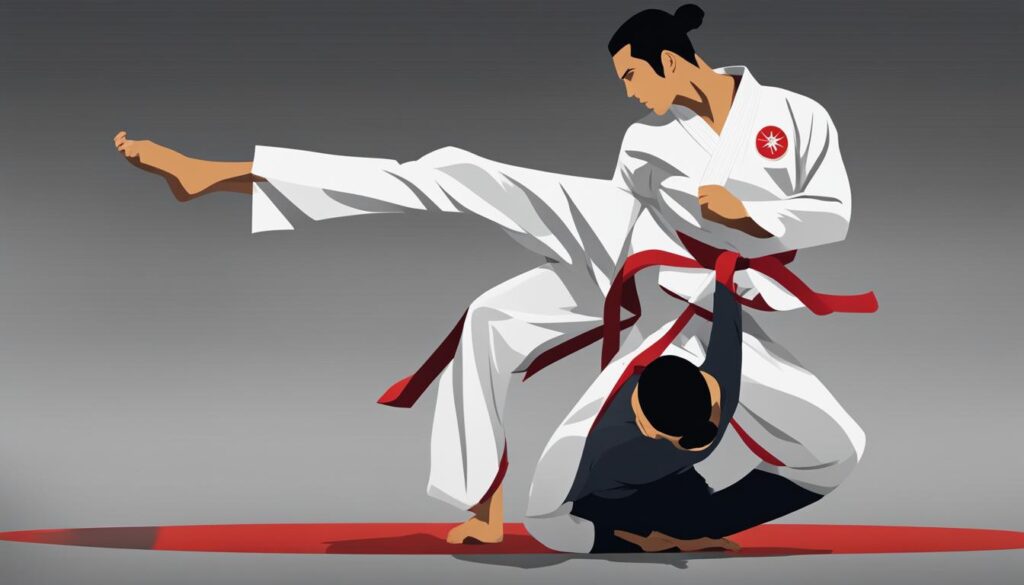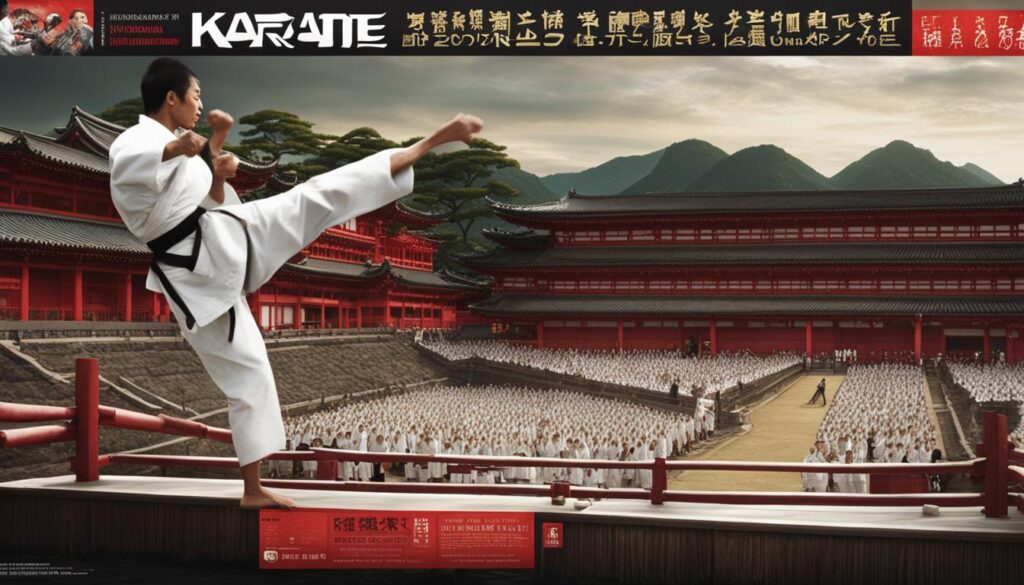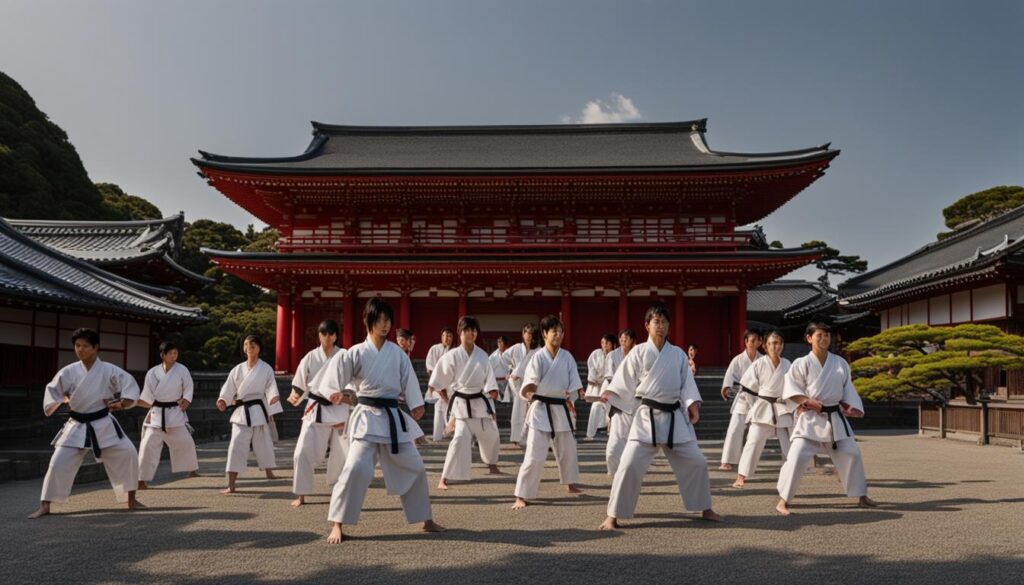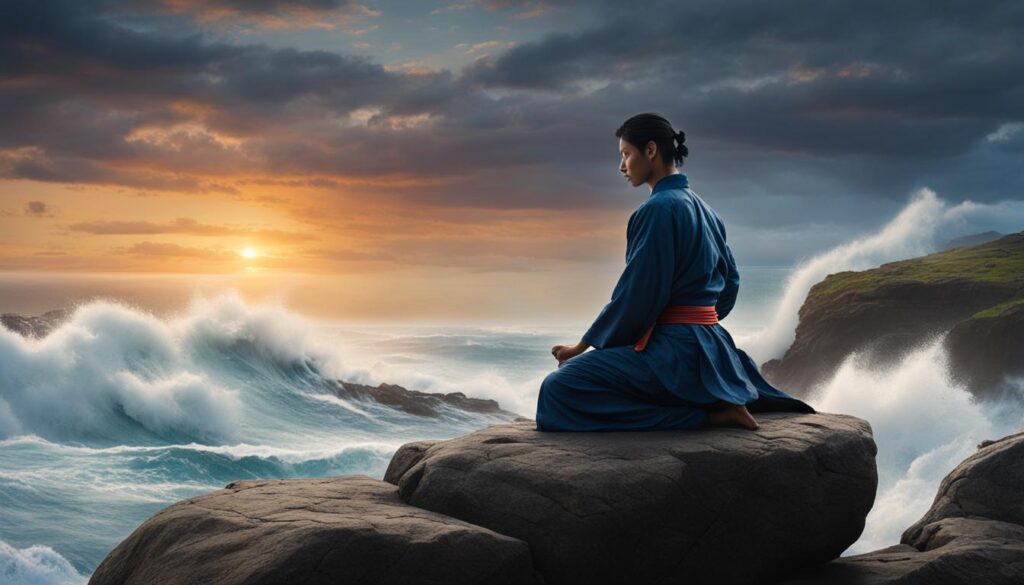Karate, also known as Karate-do, is a martial art that originated in the Ryukyu Kingdom, present-day Okinawa, Japan. It has a rich and fascinating history that traces back centuries. In this article, we will explore the origins, development, and philosophy of Karate, shedding light on the pioneers who paved the way for this popular martial art.
Key Takeaways:
- Karate originated in the Ryukyu Kingdom, present-day Okinawa, Japan.
- The development of Karate was influenced by indigenous martial arts and Chinese martial arts.
- Karate incorporates striking, grappling, and self-defense techniques.
- Gichin Funakoshi played a significant role in introducing Karate to mainland Japan.
- Karate is now practiced worldwide and has become an Olympic sport.
Karate’s Origins in Okinawa
Karate’s origins can be traced back to the Ryukyu Kingdom in Okinawa, Japan. It emerged during a time of political unrest and a prohibition on weapons in the Ryukyu Islands. To protect themselves, the inhabitants developed unarmed self-defense techniques, which eventually evolved into Karate. Chinese martial arts, especially Kung Fu, had a significant influence on the development of Karate. Chinese traders and emissaries brought their fighting techniques to Okinawa, where they merged with the local traditions, giving rise to the unique martial art we know as Karate. Over time, Okinawa became a melting pot of different styles and techniques, leading to the birth of various Karate schools.
Key Influences on Karate’s Origins
| Origin | Influences |
|---|---|
| Ryukyu Kingdom | Unarmed self-defense techniques |
| China | Chinese martial arts, particularly Kung Fu |
| Okinawa | Local traditions and merging of different styles |
The Principles and Philosophy of Karate
Karate is not just a physical combat system; it embodies a philosophy that emphasizes self-discipline, respect, and self-improvement. The core principles of Karate include discipline, respect, the mind-body connection, self-defense, and continuous improvement.
Practitioners are required to cultivate discipline and self-control, instilling a sense of responsibility and perseverance. Respect is fundamental in Karate, with practitioners acknowledging their instructors, training partners, and the art itself.
The art also emphasizes the integration of the mind and body, honing physical strength, coordination, mental focus, and self-awareness. Karate is a practical self-defense system, equipping individuals with the skills to protect themselves in real-life situations.
Finally, Karate encourages continuous physical and mental improvement, with practitioners constantly striving to refine their techniques and deepen their understanding of the art.

| Principles | Philosophy | Disciplines |
|---|---|---|
| Discipline | Self-discipline | Striking techniques |
| Respect | Respect for others | Kicking techniques |
| Mind-Body Connection | Mental focus and physical coordination | Knee strikes |
| Self-defense | Practical self-defense skills | Elbow strikes |
| Continuous Improvement | Constant refinement of techniques | Open-hand techniques |
In Karate, these principles and philosophy form the foundation of the training, shaping not just the physical aspects but also the mental and spiritual growth of practitioners. By embracing these principles, Karate becomes more than just a martial art; it becomes a way of life.
The Cultural Significance of Karate
Karate is not just a martial art; it embodies the cultural heritage and identity of Okinawa and Japan. Its practice is deeply ingrained in Japanese society and extends beyond physical training. Karate promotes values such as humility, perseverance, and integrity, which are deeply rooted in Japanese culture. The art’s cultural significance lies in its ability to instill these values in practitioners, fostering personal growth, discipline, and resilience. Karate serves as a reflection of Japanese society’s emphasis on tradition, respect, and continuous self-improvement.
“Karate is not just about fighting; it’s about how well you live your life and how you treat others.”
Karate’s Evolution and Spread to the Modern World
Karate’s journey from Okinawa to the modern world began in the early 20th century, driven by influential masters like Gichin Funakoshi. Funakoshi played a pivotal role in introducing Karate to mainland Japan, where it gained popularity and contributed to the development of the Shotokan style.
In 1922, Funakoshi was invited to Tokyo to give a Karate demonstration, marking the formal introduction of Karate to Japan. This event sparked a wave of interest and led to the establishment of university Karate clubs in major Japanese universities, further spreading the art across the country.
After World War II, Karate witnessed a surge in popularity among US servicemen stationed in Okinawa. These servicemen brought Karate back to their respective countries, further fueling its global spread. The rise of martial arts movies in the 1960s and 1970s, featuring iconic martial artists like Bruce Lee, also played a significant role in boosting the international popularity of Karate.
Today, Karate is practiced by millions worldwide and has gained recognition as an Olympic sport, with its debut in 2021. The inclusion of Karate in the Olympics highlights its evolution from a traditional martial art to a globally recognized competitive sport, cementing its place in the modern world.

Through the efforts of pioneering masters and the growing interest of practitioners around the world, Karate continues to evolve and adapt to the needs of contemporary society. Its journey from the Ryukyu Kingdom to the Olympic stage is a testament to its enduring legacy and the profound impact it has had on the martial arts landscape.
The Etymology of Karate
The etymology of Karate provides insights into the history of Japanese-Chinese relations. The original term for Karate, written in kanji, meant “Chinese hand” due to the art’s Chinese origins. However, as Sino-Japanese relations became strained, the spelling of Karate changed to “empty hand” to avoid political incorrectness. The name change occurred in 1905 and was later made official by Okinawan masters in 1935. The addition of the suffix “do” denotes that Karate is not just a combat system but also a path to knowledge and self-discovery.
Understanding the etymology of Karate sheds light on its cultural and historical context. The original name “Chinese hand” reflects the art’s roots in Chinese martial arts, particularly from the Fujian White Crane style. The influence of Chinese martial arts on Karate’s development cannot be underestimated.
However, during a period of strained relations between China and Japan, the term “Chinese hand” was deemed politically sensitive. To address this issue, the name was changed to “empty hand,” emphasizing the absence of weaponry in Karate’s techniques.
The addition of the suffix “do” signifies the philosophical and spiritual aspects of Karate. It represents the pursuit of self-improvement, discipline, and enlightenment through dedicated practice.
Karate’s Origins in Okinawa
Karate, as we know it today, originated in Okinawa, Japan. The roots of this martial art can be traced back to the practice of “te,” which was developed by the Pechin class of Ryukyuans. During a time of political centralization and a ban on weapons, the people of Okinawa needed unarmed self-defense techniques to protect themselves.
Early forms of Karate were categorized based on the cities they emerged from. The three main styles that emerged were Shuri-te, Naha-te, and Tomari-te. Each style had its own unique techniques, principles, and kata (forms) that distinguished it from the others.
“Shuri-te, Naha-te, and Tomari-te were the pioneering styles of Karate that flourished in Okinawa. These styles laid the foundation for the development of Karate as we know it today.”
Chinese martial arts played a significant role in the evolution of Karate. Chinese traders brought their fighting techniques to Okinawa, influencing the development of the indigenous martial arts. Additionally, Okinawan visits to China further enriched the practice of Karate by incorporating elements of Chinese martial arts.
To summarize, Karate’s Okinawan origin can be attributed to the development of “te” as a means of self-defense during a time of political unrest and weapon bans. Shuri-te, Naha-te, and Tomari-te emerged as distinct styles, each with its own contributions to the evolution of Karate. The influence of Chinese martial arts further shaped the development of this dynamic martial art.
| Style | City of Origin | Main Characteristics |
|---|---|---|
| Shuri-te | Shuri | Focuses on quick, linear movements and dynamic strikes |
| Naha-te | Naha | Emphasizes close-range techniques, grappling, and circular movements |
| Tomari-te | Tomari | Incorporates elements of both Shuri-te and Naha-te, with a focus on versatility |
Karate on the Japanese Mainland
Karate made its way to mainland Japan in the early 20th century, coinciding with a period of migration from Okinawa to the main islands. One of the key figures in popularizing Karate in Japan was Gichin Funakoshi. In 1922, Funakoshi was invited to Tokyo to give a demonstration, marking the formal introduction of Karate to Japan. His teachings laid the foundation for the Shotokan style, which played a significant role in the global spread of Karate.
Funakoshi’s efforts aligned with the desire to develop the combat form in a Japanese style, reflecting the tensions in Japanese-Chinese relations at the time. The name change from “Chinese hand” to “empty hand” underscored the cultural and political shift in approach.

Through Funakoshi’s dedication and the subsequent efforts of many other masters, Karate became firmly established in Japan. It gained recognition as not only a martial art but also an avenue for personal growth and self-improvement. The spread of Karate clubs in major Japanese universities further enhanced its popularity, creating a platform for training and development.
Following World War II, Karate gained popularity among US servicemen stationed in Okinawa, leading to its introduction to a wider international audience. The martial arts movies of the 1960s and 1970s significantly contributed to the worldwide recognition and interest in Karate.
Today, Karate is practiced by millions of people globally and has been recognized as an official Olympic sport, with its debut in 2021. Its journey from Okinawa to the Japanese mainland and beyond exemplifies the enduring appeal and influence of this ancient martial art.
The Philosophy of Karate
Karate developed its own philosophy under the influence of masters like Gichin Funakoshi. Funakoshi emphasized the importance of purging oneself of selfish and evil thoughts and cultivating a clear mind and conscience through Karate practice. He believed that self-improvement, discipline, and understanding could be achieved through the practice of Karate. This philosophy aligned with the broader principles of Karate, such as self-discipline, respect, and continuous improvement. Karate’s philosophy extends beyond the physical combat aspect, guiding practitioners towards personal growth and self-discovery.

| Principles of Karate | Funakoshi’s Philosophy |
|---|---|
| Self-discipline | Purging oneself of selfish and evil thoughts |
| Respect | Cultivating a clear mind and conscience |
| Continuous improvement | Striving for self-improvement, discipline, and understanding |
Karate’s Evolution and Spread to the Modern World
Karate’s journey from Okinawa to the modern world began in the early 20th century, thanks to the efforts of prominent masters like Gichin Funakoshi. Funakoshi played a crucial role in introducing Karate to mainland Japan, where it quickly gained popularity and contributed to the development of the Shotokan style.
In 1922, Funakoshi was invited to Tokyo to give a Karate demonstration, marking the formal introduction of Karate to Japan’s capital city. This event ignited a spark that would eventually lead to Karate’s widespread popularity across the country. To further propagate the art, university Karate clubs were established in major Japanese universities, exposing a larger audience to the martial art’s techniques and philosophy.
The global popularity of Karate increased significantly after World War II, due in part to its adoption by US servicemen stationed in Okinawa. However, it was the martial arts movies of the 1960s and 1970s that truly propelled Karate into the international spotlight. These films showcased the dynamic techniques and fierce spirit of Karate, captivating audiences worldwide and inspiring countless individuals to take up the practice.
Today, Karate is practiced by millions of people in countries all over the world. It has transcended cultural boundaries and has become a universal martial art, celebrated for its unique blend of striking techniques, self-defense principles, and the virtues it instills in its practitioners. In recognition of its global appeal and rich history, Karate made its debut as an Olympic sport in 2021.
Karate’s Evolution and Spread to the Modern World
Karate’s journey from Okinawa to the modern world began in the early 20th century, thanks to the efforts of prominent masters like Gichin Funakoshi. Funakoshi played a vital role in introducing Karate to mainland Japan, where it quickly gained popularity and contributed to the development of the Shotokan style.
In 1922, Funakoshi was invited to Tokyo to give a Karate demonstration, marking the formal introduction of Karate to Japan’s capital. This event served as a catalyst for the spread of Karate throughout the country. To further propagate the art, university Karate clubs were established in major Japanese universities, attracting a new generation of enthusiasts.
Following World War II, Karate experienced a surge in popularity among US servicemen stationed in Okinawa. They were exposed to the art and its techniques, leading to its spread beyond Japan’s borders.
Martial arts movies of the 1960s and 1970s, such as Bruce Lee’s films and “The Karate Kid,” played a significant role in increasing the global popularity of Karate. These movies showcased the art’s dynamic techniques and philosophy, inspiring countless individuals to learn and practice Karate.
Today, Karate has evolved into a global phenomenon, practiced by millions of people worldwide. It has gained recognition as an Olympic sport, finally making its debut in the 2021 Olympics. This milestone further solidified Karate’s place as a respected martial art and showcased its international reach and influence.
The evolution and spread of Karate from its humble origins in Okinawa to becoming an Olympic sport exemplify its enduring appeal and the dedication of its practitioners. As Karate continues to evolve and adapt, its legacy and impact on the martial arts community remain strong, ensuring its prominence for generations to come.
Conclusion
Karate’s rich history and development can be traced back to its origins in the Ryukyu Kingdom of Okinawa, Japan. Evolving from indigenous martial arts and influenced by Chinese techniques, Karate has grown into a dynamic and powerful striking art. It incorporates elements of grappling, self-defense, and continuous improvement, making it a comprehensive discipline for practitioners.
Throughout the years, Karate has spread beyond Okinawa to mainland Japan and gained popularity worldwide. It has contributed to the development of various Karate styles, each with its unique techniques and traditions. Today, Karate has achieved global recognition and status as an Olympic sport, reflecting its widespread appeal and significance.
What sets Karate apart is not just its physical prowess but also its philosophy. Karate emphasizes self-discipline, respect, and self-improvement. Practitioners are encouraged to cultivate personal growth and embody Japanese cultural values, such as humility, perseverance, and integrity. By following this path, Karate offers a transformative journey for individuals seeking physical, mental, and spiritual well-being.
With millions of practitioners around the world, Karate continues to thrive, carrying the legacy of its history and cultural heritage. Its dynamic techniques, philosophical principles, and cultural significance make it a martial art that transcends boundaries and leaves a lasting impact on those who embrace it.
FAQ
Who invented Karate?
Karate, as we know it today, developed in the Ryukyu Kingdom, present-day Okinawa, Japan. However, it is derived from indigenous martial arts of the Ryukyu Islands that were influenced by Chinese martial arts.
What is the history of Karate?
Karate originated in the Ryukyu Kingdom during a time of political unrest and a prohibition on weapons. It evolved from unarmed self-defense techniques developed by the Ryukyuan people. Over time, it was influenced by Chinese martial arts and spread to mainland Japan, gaining popularity and contributing to the development of various Karate styles.
What are the origins of Karate?
Karate’s origins can be traced back to the Ryukyu Kingdom in Okinawa, Japan. It emerged from indigenous martial arts practiced by the Pechin class of Ryukyuans. These martial arts developed as a response to political centralization and a ban on weapons.
What are the principles of Karate?
The principles of Karate include discipline, respect, the mind-body connection, self-defense, and continuous improvement. Practitioners strive to cultivate discipline, self-control, and respect for their instructors, training partners, and the art itself. Karate also emphasizes the integration of the mind and body, physical and mental strength, and self-awareness.
What is the cultural significance of Karate?
Karate embodies the cultural heritage and identity of Okinawa and Japan. It promotes values such as humility, perseverance, and integrity, which are deeply rooted in Japanese culture. Karate serves as a reflection of Japanese society’s emphasis on tradition, respect, and continuous self-improvement.
How did Karate evolve and spread to the modern world?
Karate’s journey from Okinawa to the modern world began in the early 20th century with the efforts of prominent masters like Gichin Funakoshi. Funakoshi introduced Karate to mainland Japan, where it gained popularity and contributed to the development of the Shotokan style. Karate was further propagated through university Karate clubs and gained international recognition through martial arts movies. It became an Olympic sport in 2021.
What is the etymology of Karate?
The original term for Karate meant “Chinese hand” due to its Chinese origins. However, the name was changed to “empty hand” in the early 20th century to avoid political incorrectness. The name change reflects tensions in Japanese-Chinese relations and the desire to develop the art in a Japanese style.
What are the different styles of Karate?
Karate has developed various styles over time, influenced by different regions and masters. Some of the notable styles include Shotokan, Goju-Ryu, Wado-Ryu, Shito-Ryu, and Kyokushin. Each style has its own unique techniques, principles, and training methods.
How did Karate spread from Okinawa to mainland Japan?
Karate was introduced to mainland Japan in the early 20th century when there was a migration from Okinawa to the main islands of Japan. Gichin Funakoshi played a crucial role in popularizing Karate in Japan. In 1922, he was invited to Tokyo to give a demonstration, which marked the formal introduction of Karate to Japan.
What is the philosophy of Karate?
The philosophy of Karate emphasizes self-improvement, discipline, and understanding. It encourages practitioners to purge themselves of selfish and evil thoughts and cultivate a clear mind and conscience. Karate is seen as a path to personal growth, self-discovery, and the development of physical and mental strength.
